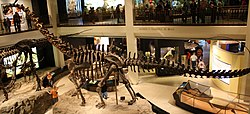Galeamopus
|
Galeamopus Temporal range: Late Jurassic, 155 Ma |
|
|---|---|
 |
|
| Mounted G. hayi holotype skeleton, Houston Museum of Natural Science | |
| Scientific classification | |
| Kingdom: | Animalia |
| Phylum: | Chordata |
| Class: | Reptilia |
| Order: | Saurischia |
| Suborder: | Sauropodomorpha |
| Family: | † Diplodocidae |
| Subfamily: | † Diplodocinae |
| Genus: |
† Galeamopus Tschopp, et al. 2015 |
| Species | |
| Synonyms | |
|
Diplodocus hayi Holland, 1924 (type) |
|
Diplodocus hayi Holland, 1924 (type)
Galeamopus is a genus of herbivorous diplodocid sauropod dinosaurs. It contains one known species, Galeamopus hayi, known from the Late Jurassic lower Morrison Formation (Kimmeridgian age, about 155 million years ago) of Wyoming, United States. It is known from one of the most well preserved diplodocid fossils, a nearly complete skeleton with associated skull. An additional specimen may represent a distinct species, informally known as G. "shellensis".
Galeamopus was first known from a partial skeleton discovered by fossil hunter William H. Utterback in 1902 near Sheridan, Wyoming, in the Red Fork Powder River Quarry A. In 1906, the skeleton was referred to Diplodocus by William Jacob Holland when he described its braincase. The specimen was classified by Holland as a new species of Diplodocus, Diplodocus hayi, in 1924. The specific name honoured Oliver Perry Hay.
In 2015, it was renamed as the separate genus Galeamopus by Emanuel Tschopp, Octávio Mateus and Roger Benson. The generic name is derived from Latin galeam, the accusative of galea, "helmet", and opus, "need". The combination is intended as a translation of Wil-helm, literally "want helmet", in reference to the first name of both Utterback and Holland. The name is at the same time an allusion to the fact that the brittle braincase of the type specimen is in need of a helmet.
The genoholotype is HMNS 175 (previously CM 662), the original skeleton. It was found in layer of the lower Morrison Formation dating from the Kimmeridgian. This specimen is also the holotype of Galeamopus hayi, the combinatio nova of the type species D. hayi. Several other specimens were referred to the genus Galeamopus but not to Galeamopus hayi. These included specimen AMNH 969, a nearly complete skull discovered in 1903 at the Bone Cabin Quarry by Peter Kaisen; specimen USNM 2673, a partial skull excavated in 1884 by Marshall P. Felch at Garden Park in Colorado; and SMA 0011, a skeleton nicknamed "Max" and found in June 1995 by Ben Pabst at the Howe-Stephens Quarry. SMA 0011 was sufficiently different to consider naming a separate species for it. This specimen (along with AMNH 969) was named G. shellensis in Tschopp's 2013 thesis. However the ICZN does not recognize thesis names as valid, so it will remain informal until the description is published.
...
Wikipedia
